国际市场营销双语共27页
[精选]国际市场营销学培训讲义英文版
![[精选]国际市场营销学培训讲义英文版](https://img.taocdn.com/s3/m/42479c3153d380eb6294dd88d0d233d4b14e3f00.png)
The scope and challenge of International Marketing
starting point focus means endsSelling factory products selling profit and through promotion sales volumeMarketing target customer integrated profit market needs marketing through and wants customer satisfaction
The scope and challenge of International Marketing
Why do companies engage in International Marketing? - To increase their profit by increasing total revenue or decreasing the cost of goods. - The attractiveness of International market - The saturation of domestic market needs and intensive market competition - (be continue)
and through摩根,英联,达能与蒙牛Political-试和你的小组成员就以下问题展开讨论:19:20:3719:20:3719:2010/30/2022 7:20:37 PM2008年1月1日,中国运动品牌老大李宁将其触角伸向了美国耐克总部所在地的波特兰,建立第一个海外鞋产品研发中心。11、以我独沈久,愧君相见频。Political-海尔相信本土化制造是海尔国际化道路上关键的一步。世界跨国公司大多选择劳力成本低的地区开设工厂。在马城旗舰店开张之前,两位荷兰企业家曾多次上门拜访李宁北京总部,试图说服李宁与他们联手,共同打拼欧洲市场。市场营销学中4P指的是什么? 4C呢?and throughProduct– standaliation or adaptation?.15、楚塞三湘接,荆门九派通。
国际市场营销(双语版)7.InternationalProductPricing

成本加成定价法 Markup Pricing
产品售价= 单位产品总成本×(1+加成率)
产品售价=
进货价格 1-加成率
Vanessa Chen Applied Foreign Languages Department, PYP
成本加成定价法
1. 例:某小型收录机单位成本100元,利润率 为40%,则其价格: 100X(1+40%)=140(元)
Price Elasticity of Demand
需求价格弹性:E=((QP22--
Q1)/ P1)/
Q1 P1
A. Inelastic Demand Demand Hardly Changes With a Small Change in Price.
P2
P1
Price
Quantity DemandQe2d pQe1r Period
Maximum Current Profit, Etc.
Market Share Leadership Low as Possible Prices to Become
the Market Share Leader.
Product Quality Leadership High Prices to Cover Higher
而加深消费者对商品价值的理解从而提高其愿意支付的价格限度的主要方法是搞好产品的市场定位突出产品特征加深消费者对产品的印象二需求差异定价法需求量定价法需求弹性定价法地区差别定价法季节差别定价顾客差别定价产品差别定价vanessachenappliedforeignlanguagesdepartmentpyp认知价值定价法为什么要为卡特彼勒公司的拖拉机多付10000美元90000相当于竞争对手的拖拉机的价格7000更耐用6000更可靠5000更优质的服务2000零部件更长时间的担保110000顾客认知价值10000折扣额100000最终价格vanessachenappliedforeignlanguagesdepartmentpyp需求弹性定价法某种商品售价是36元需求弹性为05如何变动价格才能促使某种商品销售量增加二需求弹性值需求变化率价格变化率价格变化率需求变化率需求弹性值20054036x40144降价后的价格36144216元vanessachenappliedforeignlanguagesdepartmentpyp差别定价1对不同顾客群定不同价格2不同花色式样定不同价格3不同部位位置定不同价格4不同时间定不同价格vanessachenappliedforeignlanguagesdepartmentpypcompetitionbasedpricingsealedbidcompanysetspricesbasedthinkcompetitorschargegoingratecompanysetspricesbasedwhatcompetitorschargingvanessachenappliedforeignlanguagesdepartmentpyp73pricingstrategiestactics一新产品定价策略二心理定价策略三折扣与折让策略四系列产品定价策略五地区定价策略六价格变动策略vanessachenappliedforeignlanguagesdepartmentpyp73pricingstrategiestactics一高价策略1
国际市场营销(双语版)3.TheInternationalMarketingResearch
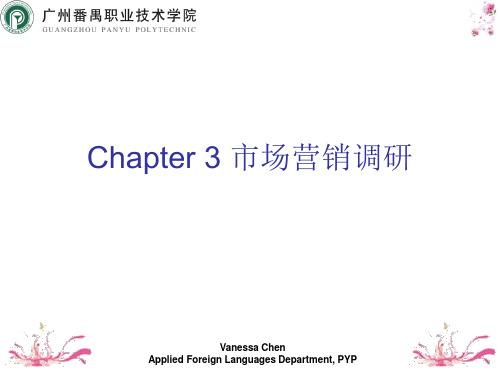
Vanessa Chen Applied Foreign Languages Department, PYP
教学目标
Understand the procedure and methods to conduct the marketing research 掌握市场调查的程序和方法
(4) Analyse the information 分析信息
Statistical methods:
Excel, SPSS, Minitab
Researchers can use them to build tables and graphs, and draw the conclusion.
Vanessa Chen School of Foreign Languages & Trade, GZPYP
(5) Report the findings 撰写调研总结报告
the research report contains the following parts:
Cover (封面) Contents (目录) Abstract (摘要) Introduction (引言) Methodology and result analysis (方法与数据分析) Conclusion and suggestions (结论与建议) Appendix (附录)
Secondary data
由他人搜集并整理的现成资料。 •内部二手资料,会计账目,销售记录等 •外部的二手资料
Vanessa Chen School of Foreign Languages & Trade, GZPYP
International marketing research approaches国际市场营销调研方法
国际市场营销(双语版)3.TheInternationalMarketingResearch

(5) Report the findings 撰写调研总结报告
the research report contains the following parts:
Cover (封面) Contents (目录) Abstract (摘要) Introduction (引言) Methodology and result analysis (方法与数据分析) Conclusion and suggestions (结论与建议) Appendix (附录)
(4) Analyse the information 分析信息
Statistical methods:
Excel, SPSS, Minitab
Researchers can use them to build tables and graphs, and draw the conclusion.
Vanessa Chen School of Foreign Languages & T
Vanessa Chen School of Foreign Languages & Trade, GZPYP
五、提出结论
1. 使用飞机上电话服务的主要原因是:有紧急情况,紧迫的商业 交易,飞行时间上的混乱,等等。用电话来消磨时间的现象是不大 会发生的。绝大多数的电话是商人所打的,并且他们要报销单。
The problems defining should not be too narrow or too broad.
Background information search.
国际市场营销(双语)课程International-Marketing-Case-Study
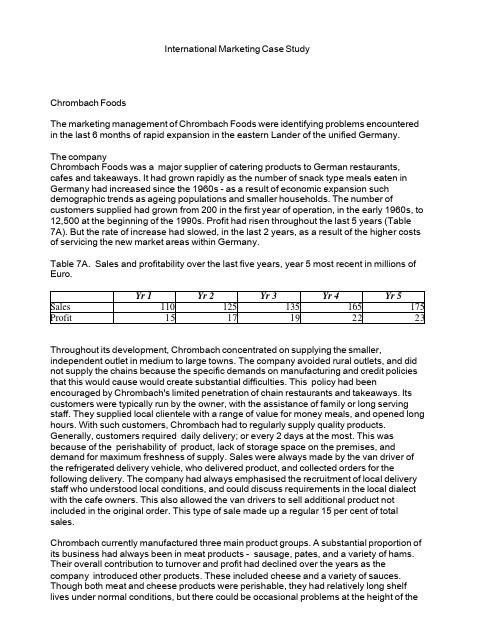
International Marketing Case StudyChrombach FoodsThe marketing management of Chrombach Foods were identifying problems encountered in the last 6 months of rapid expansion in the eastern Lander of the unified Germany.The companyChrombach Foods was a major supplier of catering products to German restaurants, cafes and takeaways. It had grown rapidly as the number of snack type meals eaten in Germany had increased since the 1960s - as a result of economic expansion such demographic trends as ageing populations and smaller households. The number of customers supplied had grown from 200 in the first year of operation, in the early 1960s, to 12,500 at the beginning of the 1990s. Profit had risen throughout the last 5 years (Table7A). But the rate of increase had slowed, in the last 2 years, as a result of the higher costs of servicing the new market areas within Germany.Table 7A. Sales and profitability over the last five years, year 5 most recent in millions of Euro.Yr 1Yr 2Yr 3Yr 4Yr 5 Sales110125135165175 Profit1517192223 Throughout its development, Chrombach concentrated on supplying the smaller, independent outlet in medium to large towns. The company avoided rural outlets, and did not supply the chains because the specific demands on manufacturing and credit policies that this would cause would create substantial difficulties. This policy had been encouraged by Chrombach's limited penetration of chain restaurants and takeaways. Its customers were typically run by the owner, with the assistance of family or long serving staff. They supplied local clientele with a range of value for money meals, and opened long hours. With such customers, Chrombach had to regularly supply quality products. Generally, customers required daily delivery; or every 2 days at the most. This was because of the perishability of product, lack of storage space on the premises, and demand for maximum freshness of supply. Sales were always made by the van driver of the refrigerated delivery vehicle, who delivered product, and collected orders for the following delivery. The company had always emphasised the recruitment of local delivery staff who understood local conditions, and could discuss requirements in the local dialect with the cafe owners. This also allowed the van drivers to sell additional product not included in the original order. This type of sale made up a regular 15 per cent of total sales.Chrombach currently manufactured three main product groups. A substantial proportion of its business had always been in meat products - sausage, pates, and a variety of hams. Their overall contribution to turnover and profit had declined over the years as the company introduced other products. These included cheese and a variety of sauces. Though both meat and cheese products were perishable, they had relatively long shelf lives under normal conditions, but there could be occasional problems at the height of the。
国际市场营销双语-精品.ppt

国际市场营销学
2
Marketing Promotion
国际市场营销学
3
内容简介 Learning Objectives
1. The changing face of U.S. business 2. The scope of the international marketing task
3. The increasing importance of global awareness
风险大, 难度大 Higher Risk and More Difficulties
国际市场营销学
9
1.2 国际市场营销与国际贸易
International Marketing & International Trade
国际贸易: 国家之间有形产品与无形服务的交换活动
Exchange of the visible products and invisible services among the nations 国与国之间分工的结果
Outcome of the International Labor Division
国际市场营销学
10
国际贸易与国际营销的共同点
What are in common for the both?
经营活动的目的:获取利润
Business Purpose: Earning profit 交换对象:商品和劳务
Marketing and International Marketing
Marketing is a social and managerial process by which individuals and groups obtain what they need and wue with others.
国际市场营销英文版PPT课件
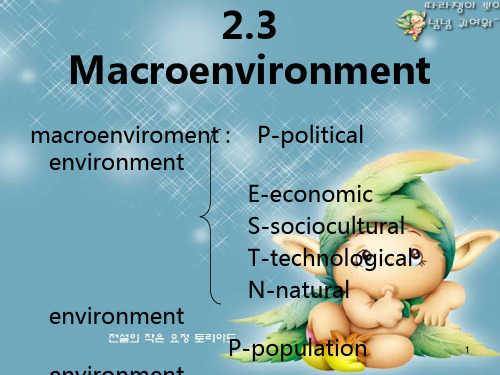
Sociocultural Environment
• Sociocultural environmrnt 1) high persistence core cultural
values 2) existence of subcultures 3) shift of secondary cultural values through time
4
Economic Environment
I The economic environment for marketing comprises the overall economy
II It includes: Business cycles Spending patterns Consumer income issues
• It provides important opportunities to improve customer value
Prosperity production employment demand
Recession production employment demand
Recovery production employment demand
• Consumer Income It influences whether or not consumers 6
5
• Business cycles and Spending patterns Spending patterns are linked to the
business cycle. The level of business activity that moves from prosperity to recession, to recovery.
国际市场营销双语

4. Culture
5. PoliticalLegal
3. Economy 3. Economy
国际市场营销
International Marketing (双语教学)
山西财经大学 国际贸易学院 药朝诚
国际市场营销学
1
第一部分 国际市场营销导论
Guiding Theories of International Marketing
一、市场营销学的基础知识
Marketing Essentials
国际贸易、国际金融、跨国公司、现代技术 革命
国际市场营销学
17
可口可乐的应对策略
Coca-cola - from international to global
Before the mid-1990s
In charge of U.S. operations
President
In charge of international operations
贸易保护主义 Trade Protectionism
贸易区域集团化 Regional Economic Bloc
国际市场营销学
16
经济全球化
The Economic Globalization
经济全球化是指世界各国经济在生产、交换、 分配及消费四大环节的全球一体化,是资源 与生产要素在全球范围进行配置,使各国经 济彼此之间的联系及相互依赖日益加强,任 何一个国家或地区都不能与世界经济脱节而 单独生存和发展
国际市场营销学
8
国际市场营销的特点
Characteristics of the International Marketing
市场容量大,竞争激烈 Bigger market and Stronger Competition
国际市场营销(双语版)2.TheInternationalMarketingenvironment

mothers. They thought
just changed diapers for
Pampers were too thick,
babies twice a day—morning
because they changed Pampers from P & G and evening. Therefore
The Marketing Environment
Vanessa Chen Applied Foreign Languages Department, PYP
2.1.2 市场营销环境与企业营销活动
市场营销环境是企业生存和发展的条件, 对企业具有强制性,企业必须适应环境, 然而企业又具有能动性,对环境具有反作 用。
正面影响 负面影响
Vanessa Chen Applied Foreign Languages Department, PYP
不知道
契机——生活方式
新住房 新汽车 节日 旅行 分期消费 交通 退休 疾病 保险 购物 饮食
正面影响 负面影响
Vanessa Chen Applied Foreign Languages Department, PYP
= PI-所得税- 非商业性开支 = 个人消费+储蓄/投资 eg.2001我国城镇人均DPI=6,280元,Max上海=10,000
△ 可自由支配的个人收入 = DPI-储蓄-购买生活必需品的固定开支
2、区别货币收入 & 实际收入
Vanessa Chen Applied Foreign Languages Department, PYP
vanessachenappliedforeignlanguagesdepartmentpyp213市场营销环境的综合分析方法swotso战略利用优势利用机会战略利用优势利用机会wo战略利用机会克服劣势战略利用机会克服劣势st战略利用优势回避威胁战略利用优势回避威胁wt战略回避威胁克服劣势战略回避威胁克服劣势优势strengths劣势weakness机会opportunities威胁threats优势strengths劣势weakness机会opportunities威胁threatsvanessachenappliedforeignlanguagesdepartmentpypso战略公司优势机会战略公司优势机会战略中央电视台垄断广告需求大广告招标长虹低成本康佳换届价格战海尔管理品牌休克鱼兼并中央电视台垄断广告需求大广告招标长虹低成本康佳换届价格战海尔管理品牌休克鱼兼并vanessachenappliedforeignlanguagesdepartmentpyp抓住契机主动出击?仔细阅读下面的这些表并且加以应用?正面影响
国际市场营销双语教学教案
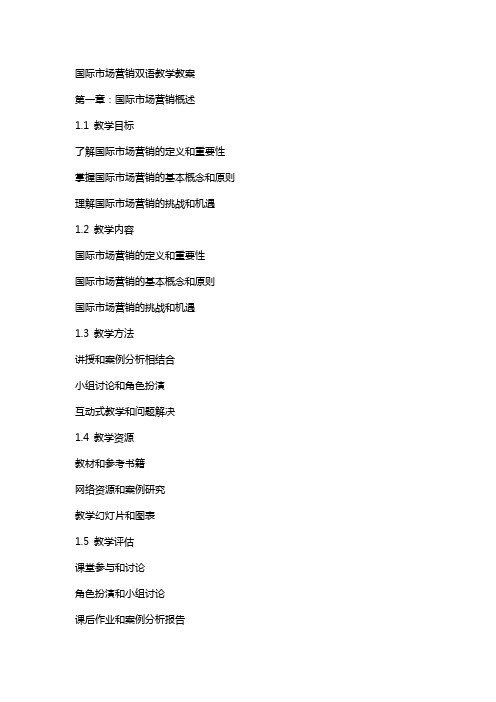
国际市场营销双语教学教案第一章:国际市场营销概述1.1 教学目标了解国际市场营销的定义和重要性掌握国际市场营销的基本概念和原则理解国际市场营销的挑战和机遇1.2 教学内容国际市场营销的定义和重要性国际市场营销的基本概念和原则国际市场营销的挑战和机遇1.3 教学方法讲授和案例分析相结合小组讨论和角色扮演互动式教学和问题解决1.4 教学资源教材和参考书籍网络资源和案例研究教学幻灯片和图表1.5 教学评估课堂参与和讨论角色扮演和小组讨论课后作业和案例分析报告第二章:国际市场营销环境2.1 教学目标了解国际市场营销环境的构成因素掌握国际市场营销环境的变化趋势理解国际市场营销环境的挑战和机遇2.2 教学内容国际市场营销环境的构成因素国际市场营销环境的变化趋势国际市场营销环境的挑战和机遇2.3 教学方法讲授和案例分析相结合小组讨论和角色扮演互动式教学和问题解决2.4 教学资源教材和参考书籍网络资源和案例研究教学幻灯片和图表2.5 教学评估课堂参与和讨论角色扮演和小组讨论课后作业和案例分析报告第三章:国际市场营销战略3.1 教学目标了解国际市场营销战略的制定过程掌握国际市场营销战略的基本要素理解国际市场营销战略的实施和评估3.2 教学内容国际市场营销战略的制定过程国际市场营销战略的基本要素国际市场营销战略的实施和评估3.3 教学方法讲授和案例分析相结合小组讨论和角色扮演互动式教学和问题解决3.4 教学资源教材和参考书籍网络资源和案例研究教学幻灯片和图表3.5 教学评估课堂参与和讨论角色扮演和小组讨论课后作业和案例分析报告第四章:国际市场营销产品策略4.1 教学目标掌握国际市场营销产品策略的基本要素理解国际市场营销产品策略的实施和评估4.2 教学内容国际市场营销产品策略的重要性国际市场营销产品策略的基本要素国际市场营销产品策略的实施和评估4.3 教学方法讲授和案例分析相结合小组讨论和角色扮演互动式教学和问题解决4.4 教学资源教材和参考书籍网络资源和案例研究教学幻灯片和图表4.5 教学评估课堂参与和讨论角色扮演和小组讨论课后作业和案例分析报告第五章:国际市场营销渠道策略5.1 教学目标了解国际市场营销渠道策略的重要性理解国际市场营销渠道策略的实施和评估5.2 教学内容国际市场营销渠道策略的重要性国际市场营销渠道策略的基本要素国际市场营销渠道策略的实施和评估5.3 教学方法讲授和案例分析相结合小组讨论和角色扮演互动式教学和问题解决5.4 教学资源教材和参考书籍网络资源和案例研究教学幻灯片和图表5.5 教学评估课堂参与和讨论角色扮演和小组讨论课后作业和案例分析报告第六章:国际市场营销传播策略6.1 教学目标理解国际市场营销传播策略的基本概念掌握国际市场营销传播策略的制定和实施方法6.2 教学内容国际市场营销传播策略的基本概念国际市场营销传播策略的制定和实施方法国际市场营销传播策略的有效运用6.3 教学方法讲授和案例分析相结合小组讨论和角色扮演互动式教学和问题解决6.4 教学资源教材和参考书籍网络资源和案例研究教学幻灯片和图表6.5 教学评估课堂参与和讨论角色扮演和小组讨论课后作业和案例分析报告第七章:国际市场营销价格策略7.1 教学目标理解国际市场营销价格策略的重要性掌握国际市场营销价格策略的基本要素学习国际市场营销价格策略的制定和评估7.2 教学内容国际市场营销价格策略的重要性国际市场营销价格策略的基本要素国际市场营销价格策略的制定和评估7.3 教学方法讲授和案例分析相结合小组讨论和角色扮演互动式教学和问题解决7.4 教学资源教材和参考书籍网络资源和案例研究教学幻灯片和图表7.5 教学评估课堂参与和讨论角色扮演和小组讨论课后作业和案例分析报告第八章:国际市场营销服务策略8.1 教学目标理解国际市场营销服务策略的基本概念掌握国际市场营销服务策略的制定和实施方法学习国际市场营销服务策略的有效运用8.2 教学内容国际市场营销服务策略的基本概念国际市场营销服务策略的制定和实施方法国际市场营销服务策略的有效运用8.3 教学方法讲授和案例分析相结合小组讨论和角色扮演互动式教学和问题解决8.4 教学资源教材和参考书籍网络资源和案例研究教学幻灯片和图表8.5 教学评估课堂参与和讨论角色扮演和小组讨论课后作业和案例分析报告第九章:国际市场营销风险管理9.1 教学目标理解国际市场营销风险的基本概念掌握国际市场营销风险的识别和管理方法学习国际市场营销风险的有效应对策略9.2 教学内容国际市场营销风险的基本概念国际市场营销风险的识别和管理方法国际市场营销风险的有效应对策略9.3 教学方法讲授和案例分析相结合小组讨论和角色扮演互动式教学和问题解决9.4 教学资源教材和参考书籍网络资源和案例研究教学幻灯片和图表9.5 教学评估课堂参与和讨论角色扮演和小组讨论课后作业和案例分析报告第十章:国际市场营销伦理和社会责任10.1 教学目标理解国际市场营销伦理和社会责任的重要性掌握国际市场营销伦理和社会责任的基本原则学习国际市场营销伦理和社会责任的最佳实践10.2 教学内容国际市场营销伦理和社会责任的重要性国际市场营销伦理和社会责任的基本原则国际市场营销伦理和社会责任的最佳实践10.3 教学方法讲授和案例分析相结合小组讨论和角色扮演互动式教学和问题解决10.4 教学资源教材和参考书籍网络资源和案例研究教学幻灯片和图表10.5 教学评估课堂参与和讨论角色扮演和小组讨论课后作业和案例分析报告重点解析本文档为“国际市场营销双语教学教案”,共包含十个章节。
市场营销学双语资料
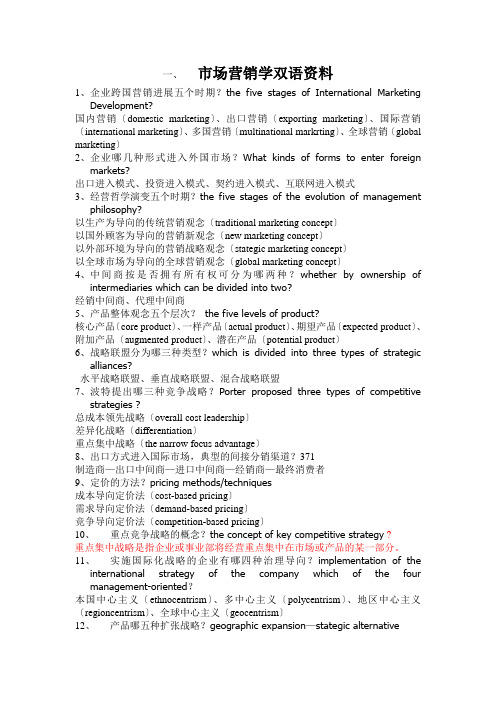
一、市场营销学双语资料1、企业跨国营销进展五个时期?the five stages of International MarketingDevelopment?国内营销〔domestic marketing〕、出口营销〔exporting marketing〕、国际营销〔international marketing〕、多国营销〔multinational markrting〕、全球营销〔global marketing〕2、企业哪几种形式进入外国市场?What kinds of forms to enter foreignmarkets?出口进入模式、投资进入模式、契约进入模式、互联网进入模式3、经营哲学演变五个时期?the five stages of the evolution of managementphilosophy?以生产为导向的传统营销观念〔traditional marketing concept〕以国外顾客为导向的营销新观念〔new marketing concept〕以外部环境为导向的营销战略观念〔stategic marketing concept〕以全球市场为导向的全球营销观念〔global marketing concept〕4、中间商按是否拥有所有权可分为哪两种?whether by ownership ofintermediaries which can be divided into two?经销中间商、代理中间商5、产品整体观念五个层次?the five levels of product?核心产品〔core product〕、一样产品〔actual product〕、期望产品〔expected product〕、附加产品〔augmented product〕、潜在产品〔potential product〕6、战略联盟分为哪三种类型?which is divided into three types of strategicalliances?水平战略联盟、垂直战略联盟、混合战略联盟7、波特提出哪三种竞争战略?Porter proposed three types of competitivestrategies ?总成本领先战略〔overall cost leadership〕差异化战略〔differentiation〕重点集中战略〔the narrow focus advantage〕8、出口方式进入国际市场,典型的间接分销渠道?371制造商—出口中间商—进口中间商—经销商—最终消费者9、定价的方法?pricing methods/techniques成本导向定价法〔cost-based pricing〕需求导向定价法〔demand-based pricing〕竞争导向定价法〔competition-based pricing〕10、重点竞争战略的概念?the concept of key competitive strategy ?重点集中战略是指企业或事业部将经营重点集中在市场或产品的某一部分。
国际市场营销(双语版) 国际市场营销管理
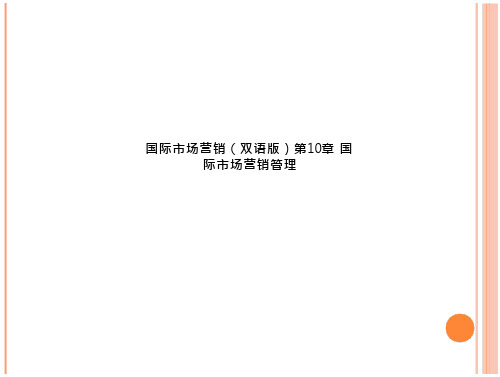
10.2 全球营销的组织结构
1. 影响组织结构的主要因素 · 1. 企业规模的大小——国内市场容量和国外市场容
量的总和及比例 · 2.运营的市场数目和所处的环境 · 3.产品的特性和多样性 · Features and diversity of the products
10.2.2 国际企业集权制
· 采用产品型组织结构的公司比较有弹性,因为当公司想发展 另一条与现有业务无关的产品线时,可以额外增加一个新的 产品部门;这种结构也有助于企业对各个产品系列给予足够 的重视,纺织企业忽略开发新产品和那些销售量虽小但有发 展潜力的产品。此方法的显著特征是分权化,部门领导有很 大的主动权,从而有较高的积极性;对国外市场环境的变化 反应敏感,增加新产品和减少老产品对企业整体活动不会产 生太大的影响。
· 一般来说,母公司偏重于经营计划。战略规划与经营计划 区别在于,前者的目的是决定营销目标和基本战略,而后 者的作用则在于将这些目标和战略付诸实施。前者是创造 性的原则计划,后者是从属于前者的具体计划。
10.1.2 国际市场营销企业计划的制订
· 1.确定任务 · 2.情况分析 · 3.确定企业目标 · 4.提出方案 · 5.评价和选择方案对方案进行评价和选择, · 6.预是一种在处理国内业务与国外业务的方式上没有 差异的组织形态。The global company is an organization form which has no difference in the way of dealing with domestic business and foreign business.
· 组织形式是否合适国际企业要受到许多因素的制约,这些因素主要有:企 业规模的大小——国内市场容量和国外市场容量的总和及比例;运营的市 场数目和所处的环境;产品的特性和多样性;国外市场层次的多少,国际 企业目标,企业国际化经验等也都会影响企业的组织结构。
国际市场营销(双语)课程zuoye

国内运动服饰市场,Nike和Adidas占有最大的领导优势,本土品 牌如Lining和Anta等,虽然销售增长快速,但要在主流市场和品牌上挑 战前两大巨头,还有很长路要走。 不过近两年,一些国外的二三线品牌在中国 做得风声水起,它们大多具有很强的设计/时尚感, 定价较高(溢价能力强),而在一二线市场增长非 常快速,其中最耀眼的当属Kappa这个意大利品牌。
Kappa的成功更多的是符合了社会消费的大潮流趋势,再加上自己的努力,所以 成功不易复制。
Kappa成功之道
作为事实上的国际二线运动品牌,2002年正式涉足中国市场的Kappa一来到中 国就遇到难题: 产品定位不准:在2002年和2003年,北京动向主要引入Kappa的专业运动系列产 品。把自己的产品全线定位在专业体育领域范畴。然而, Kappa很快发现自己深陷 “红海”:高端“专业体育品牌”的定位,意味着一上来就与耐克、阿迪达斯等顶 级专业运动品牌“硬碰硬”的较量。果然,Kappa尝到了失败的滋味。“在专业领 域,耐克和阿迪达斯赞助一个项目的钱款可能抵的上Kappa几乎全年的市场费用, 在这种情况下跟对手去硬拼只有死路一条。对手太强大了,在纯粹体育的这一块, 对手先入优势、超级细分的产品线和巨大的品牌号召力,任何一点都足以让Kappa 败下阵来。”用Kappa中国CEO秦大中的话来说就是”Kappa在错误的时间错误的 地点打了一场不对称的战争”。 水土不服:出于对意大利先进设计思想的信任,Kappa来到中国之初,将其服装、 鞋等系列产品原汁原味地搬到中国来。没想到的是,完全欧式、没有适当注入中国 本土流行元素的体育服饰,并没有获得中国消费者的认可。 2002年销售额仅为1000多万,2003年销售为4800多万。区区几千万的销售额,根 本无法维系北京动向当时的200多个专卖店的渠道成本。
市场营销 双语

Chapter 1 The Scope and Challenge of International Marketing第一章国际市场营销学的范围和挑战1. MarketingMarketing: the process of building lasting relationships through planning, executing and controlling the conception, pricing, promotion and distribution of ideas, goods and services to create mutual exchange that satisfy individual and organizational needs and objectives.营销是个人和集体通过创造,提供出售,并同他人交换产品和价值,已获得其所需所欲之物的一种社会和管理过程。
Marketing and salesMarketing is the process of seeking to uncover consumers’requirements and adopting the information to product’ distribution and promotion.Sale is to sell what that has already been produced to customers without thinking of the customers’ needs and wants.2. Basic elements of the marketing concept⑴Needs: is a state of deprivation of some basic satisfaction.需求是指没有得到某些基本满足的感受状态。
Physical needs for food, clothing, warmthSocial needs for belonging, respect and affectionIndividual needs for knowledge and self-expression(2)Wants: are devices for specific items that can satisfy those needs.欲望是指对具体满足物的愿望。
国际市场营销(双语)ch0531 Global customers

14%
Population with income>$2500 2.3%
Average household size
5.2
Growth Rate
3.5%
* One of the lowest rates of access in the world
Chapter 5/ 17
Latin America
Chapter 5/ 14
JAPAN
•Home of most demanding customers •Home market of global customers •Home market of global competitors •Significant market of global competitors •Major source of industry innovation.
Developed Countries Global Buyers Global Marketing Plan Summary
Chapter 5/ 2
Learning Objectives
Become familiar with different regional markets Learn how transitional & developing markets
Chapter 5/ 9
Eastern & Central Europe Before – After Market Economy
Before After
% World GNP 6.9%
2.5%
GNP per Capita $3,665 $2,219
Chapter 5/ 10
Marketing in Eastern & Central Europe
